engine SSANGYONG NEW ACTYON SPORTS 2013 User Guide
[x] Cancel search | Manufacturer: SSANGYONG, Model Year: 2013, Model line: NEW ACTYON SPORTS, Model: SSANGYONG NEW ACTYON SPORTS 2013Pages: 751, PDF Size: 72.63 MB
Page 32 of 751
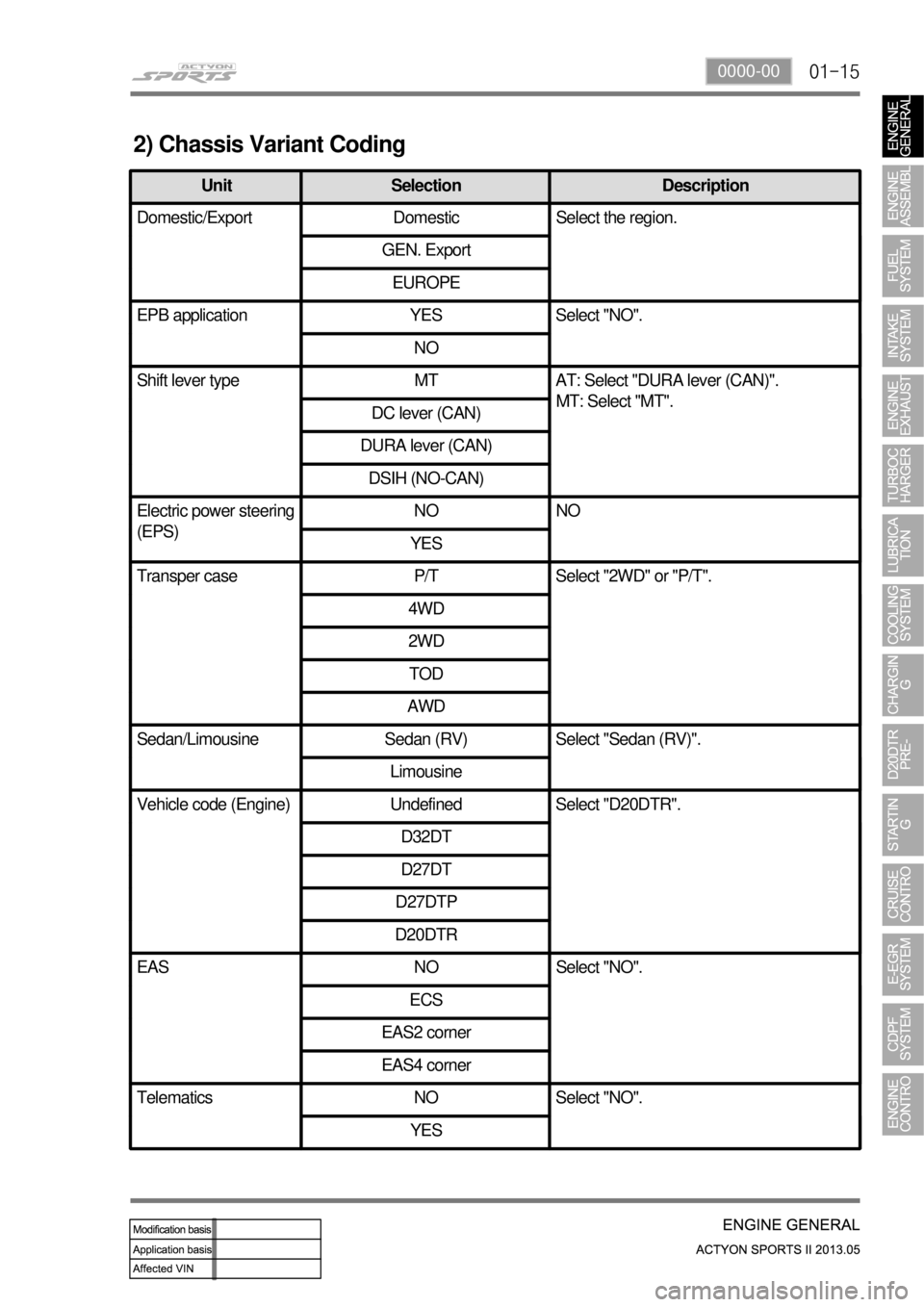
01-150000-00
2) Chassis Variant Coding
Unit Selection Description
Domestic/Export Domestic Select the region.
GEN. Export
EUROPE
EPB application YES Select "NO".
NO
Shift lever type MT AT: Select "DURA lever (CAN)".
MT: Select "MT".
DC lever (CAN)
DURA lever (CAN)
DSIH (NO-CAN)
Electric power steering
(EPS)NO NO
YES
Transper case P/T Select "2WD" or "P/T".
4WD
2WD
TOD
AWD
Sedan/Limousine Sedan (RV) Select "Sedan (RV)".
Limousine
Vehicle code (Engine) Undefined Select "D20DTR".
D32DT
D27DT
D27DTP
D20DTR
EAS NO Select "NO".
ECS
EAS2 corner
EAS4 corner
Telematics NO Select "NO".
YES
Page 38 of 751
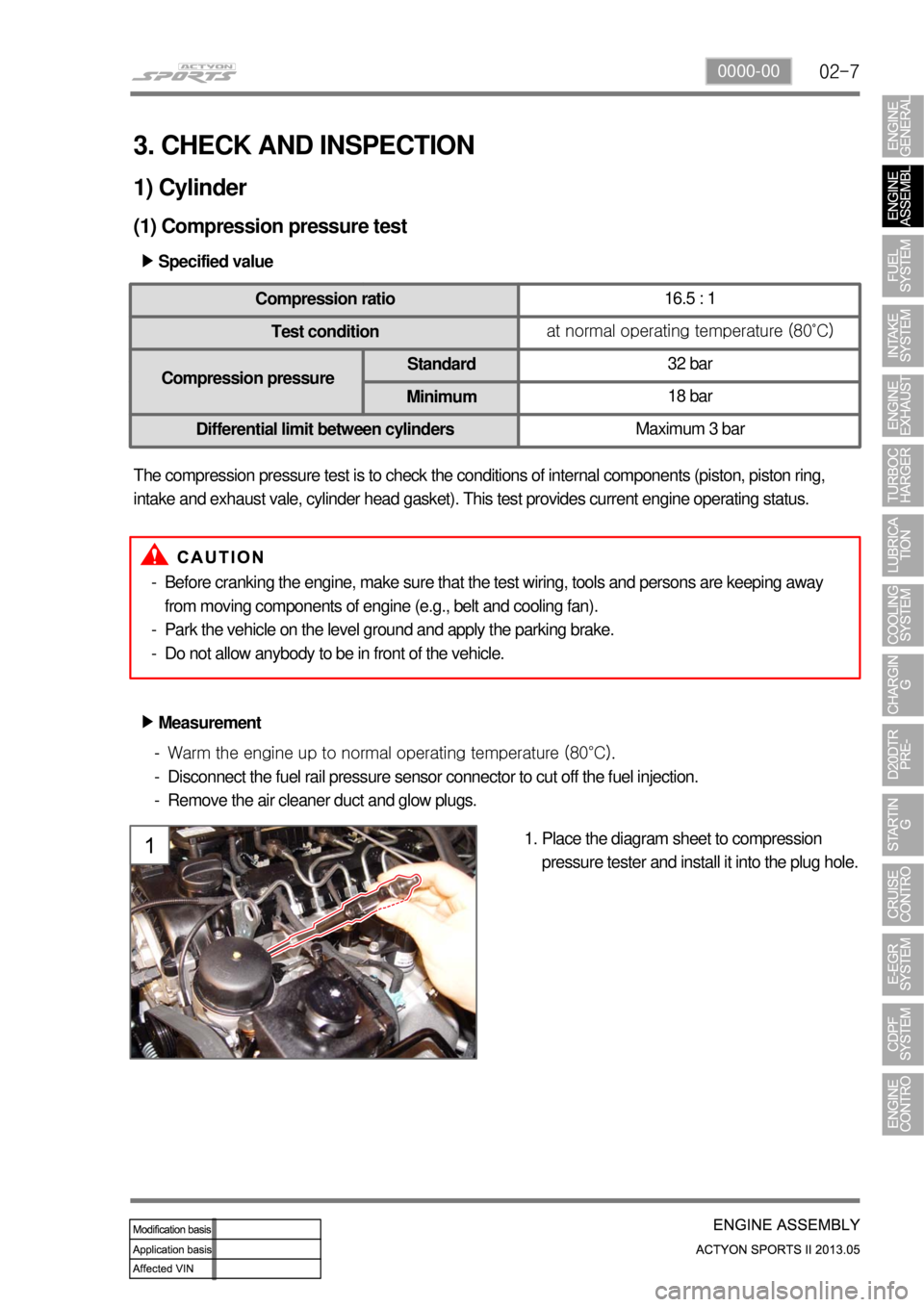
02-70000-00
3. CHECK AND INSPECTION
1) Cylinder
(1) Compression pressure test
Specified value ▶
Compression ratio16.5 : 1
Test conditionat normal operating temperature (80˚C)
Compression pressureStandard32 bar
Minimum18 bar
Differential limit between cylindersMaximum 3 bar
The compression pressure test is to check the conditions of internal components (piston, piston ring,
intake and exhaust vale, cylinder head gasket). This test provides current engine operating status.
Before cranking the engine, make sure that the test wiring, tools and persons are keeping away
from moving components of engine (e.g., belt and cooling fan).
Park the vehicle on the level ground and apply the parking brake.
Do not allow anybody to be in front of the vehicle. -
-
-
Measurement ▶
<007e0088009900940047009b008f008c0047008c0095008e00900095008c0047009c00970047009b00960047009500960099009400880093004700960097008c00990088009b00900095008e0047009b008c00940097008c00990088009b009c0099008c00
47004f005f005700b6006a00500055>
Disconnect the fuel rail pressure sensor connector to cut off the fuel injection.
Remove the air cleaner duct and glow plugs. -
-
-
Place the diagram sheet to compression
pressure tester and install it into the plug hole. 1.
Page 39 of 751
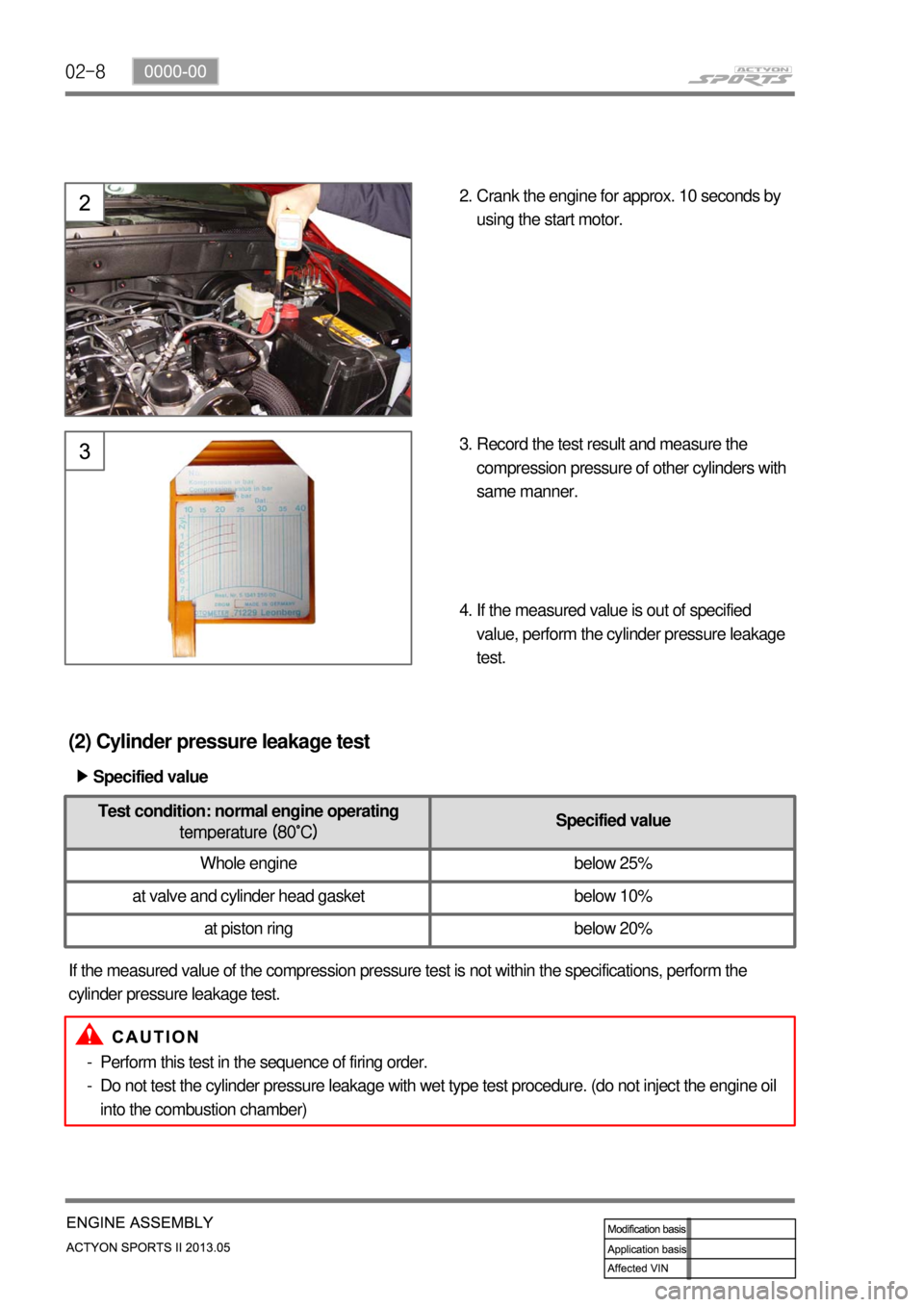
02-8
(2) Cylinder pressure leakage test
If the measured value of the compression pressure test is not within the specifications, perform the
cylinder pressure leakage test.Specified value ▶
Perform this test in the sequence of firing order.
Do not test the cylinder pressure leakage with wet type test procedure. (do not inject the engine oil
into the combustion chamber) -
-
Test condition: normal engine operating
temperature (80˚C)Specified value
Whole engine below 25%
at valve and cylinder head gasket below 10%
at piston ring below 20%
Crank the engine for approx. 10 seconds by
using the start motor. 2.
Record the test result and measure the
compression pressure of other cylinders with
same manner. 3.
If the measured value is out of specified
value, perform the cylinder pressure leakage
test. 4.
Page 42 of 751
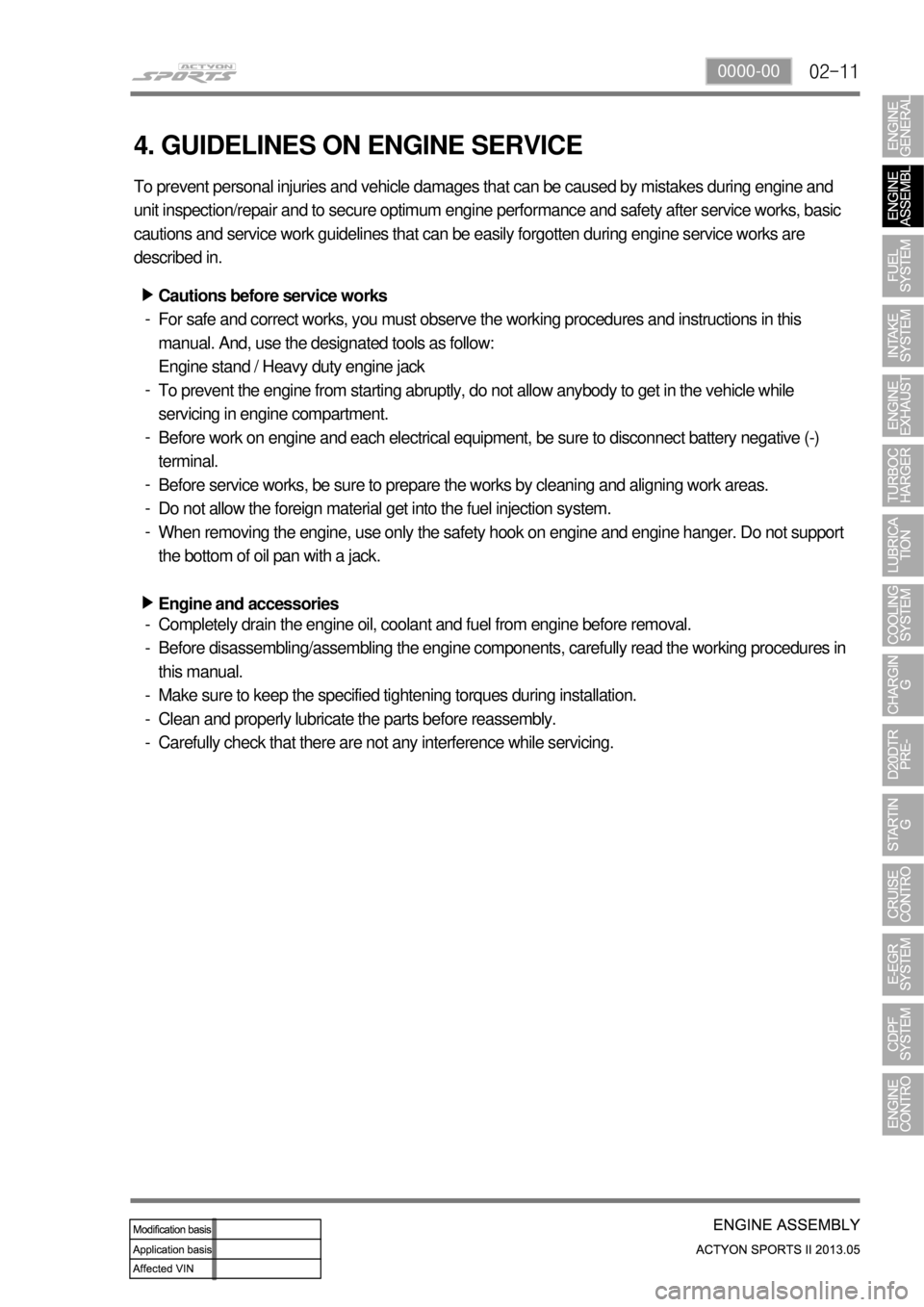
02-110000-00
4. GUIDELINES ON ENGINE SERVICE
To prevent personal injuries and vehicle damages that can be caused by mistakes during engine and
unit inspection/repair and to secure optimum engine performance and safety after service works, basic
cautions and service work guidelines that can be easily forgotten during engine service works are
described in.
Cautions before service works
For safe and correct works, you must observe the working procedures and instructions in this
manual. And, use the designated tools as follow:
Engine stand / Heavy duty engine jack
To prevent the engine from starting abruptly, do not allow anybody to get in the vehicle while
servicing in engine compartment.
Before work on engine and each electrical equipment, be sure to disconnect battery negative (-)
terminal.
Before service works, be sure to prepare the works by cleaning and aligning work areas.
Do not allow the foreign material get into the fuel injection system.
When removing the engine, use only the safety hook on engine and engine hanger. Do not support
the bottom of oil pan with a jack.
Engine and accessories ▶
-
-
-
-
-
-
▶
Completely drain the engine oil, coolant and fuel from engine before removal.
Before disassembling/assembling the engine components, carefully read the working procedures in
this manual.
Make sure to keep the specified tightening torques during installation.
Clean and properly lubricate the parts before reassembly.
Carefully check that there are not any interference while servicing. -
-
-
-
-
Page 43 of 751
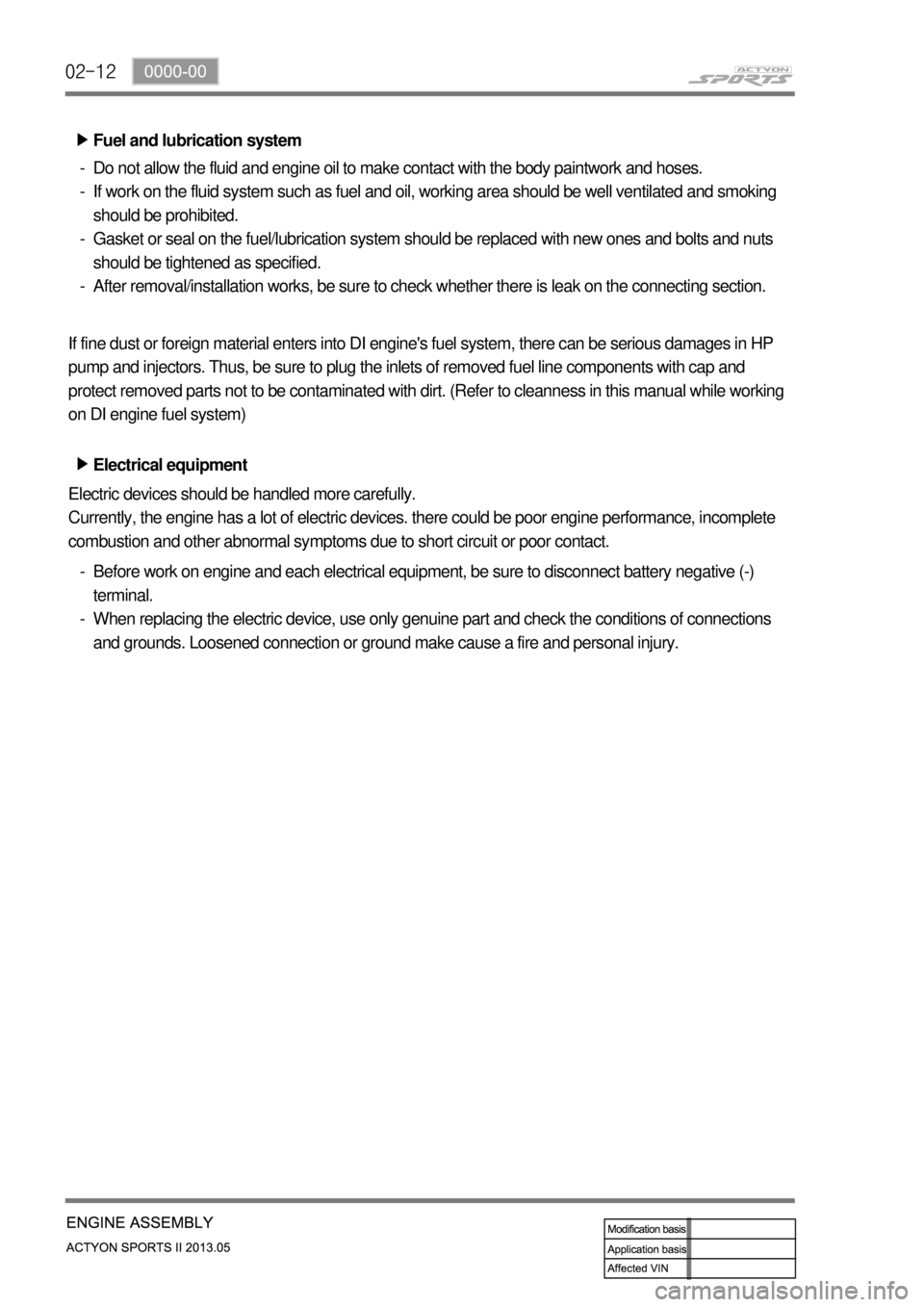
02-12
Electrical equipment ▶
Electric devices should be handled more carefully.
Currently, the engine has a lot of electric devices. there could be poor engine performance, incomplete
combustion and other abnormal symptoms due to short circuit or poor contact.
Before work on engine and each electrical equipment, be sure to disconnect battery negative (-)
terminal.
When replacing the electric device, use only genuine part and check the conditions of connections
and grounds. Loosened connection or ground make cause a fire and personal injury. -
-Fuel and lubrication system ▶
Do not allow the fluid and engine oil to make contact with the body paintwork and hoses.
If work on the fluid system such as fuel and oil, working area should be well ventilated and smoking
should be prohibited.
Gasket or seal on the fuel/lubrication system should be replaced with new ones and bolts and nuts
should be tightened as specified.
After removal/installation works, be sure to check whether there is leak on the connecting section. -
-
-
-
If fine dust or foreign material enters into DI engine's fuel system, there can be serious damages in HP
pump and injectors. Thus, be sure to plug the inlets of removed fuel line components with cap and
protect removed parts not to be contaminated with dirt. (Refer to cleanness in this manual while working
on DI engine fuel system)
Page 44 of 751
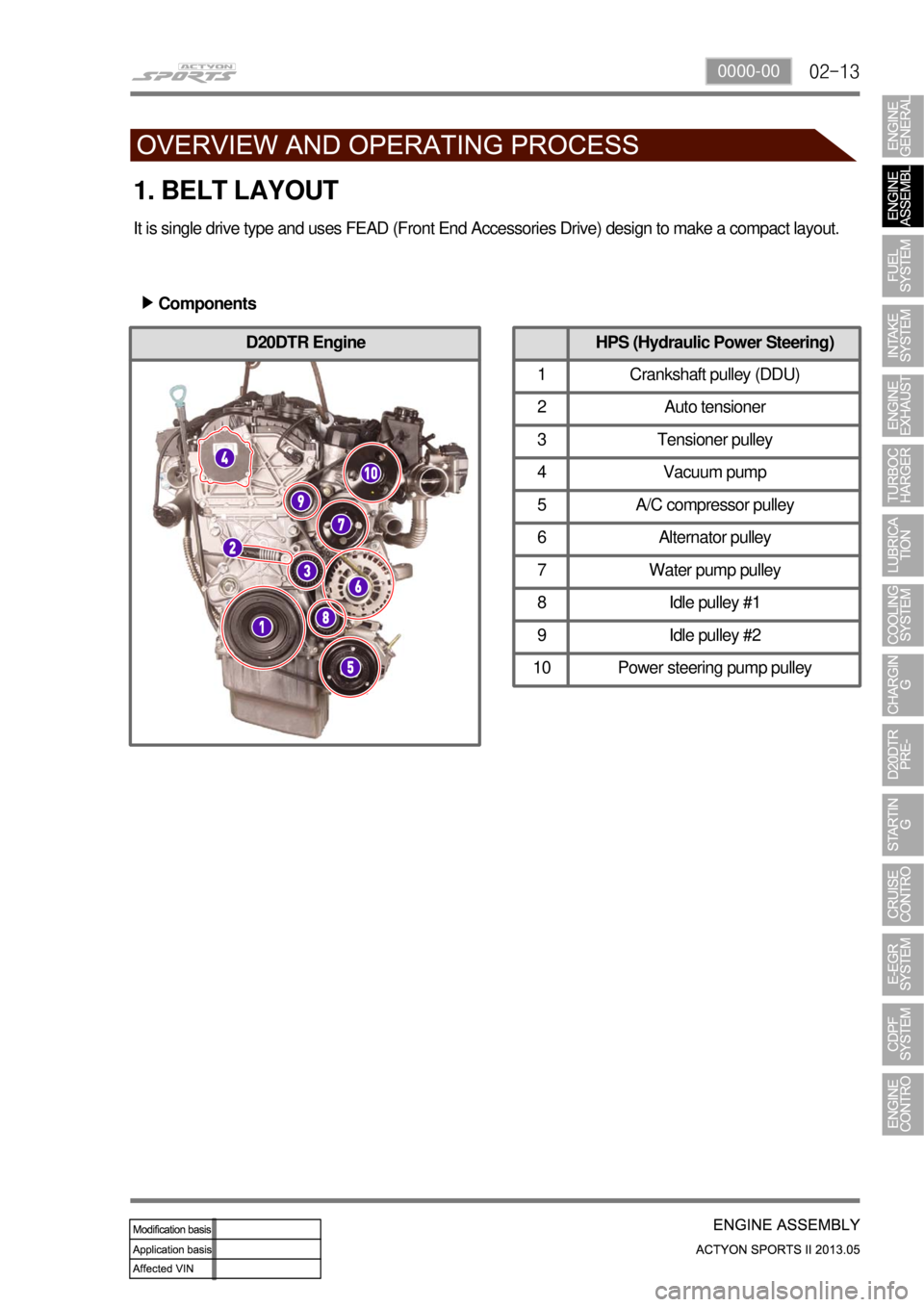
02-130000-00
D20DTR Engine
1. BELT LAYOUT
It is single drive type and uses FEAD (Front End Accessories Drive) design to make a compact layout.
Components ▶
HPS (Hydraulic Power Steering)
1 Crankshaft pulley (DDU)
2 Auto tensioner
3 Tensioner pulley
4 Vacuum pump
5 A/C compressor pulley
6 Alternator pulley
7 Water pump pulley
8 Idle pulley #1
9 Idle pulley #2
10 Power steering pump pulley
Page 47 of 751
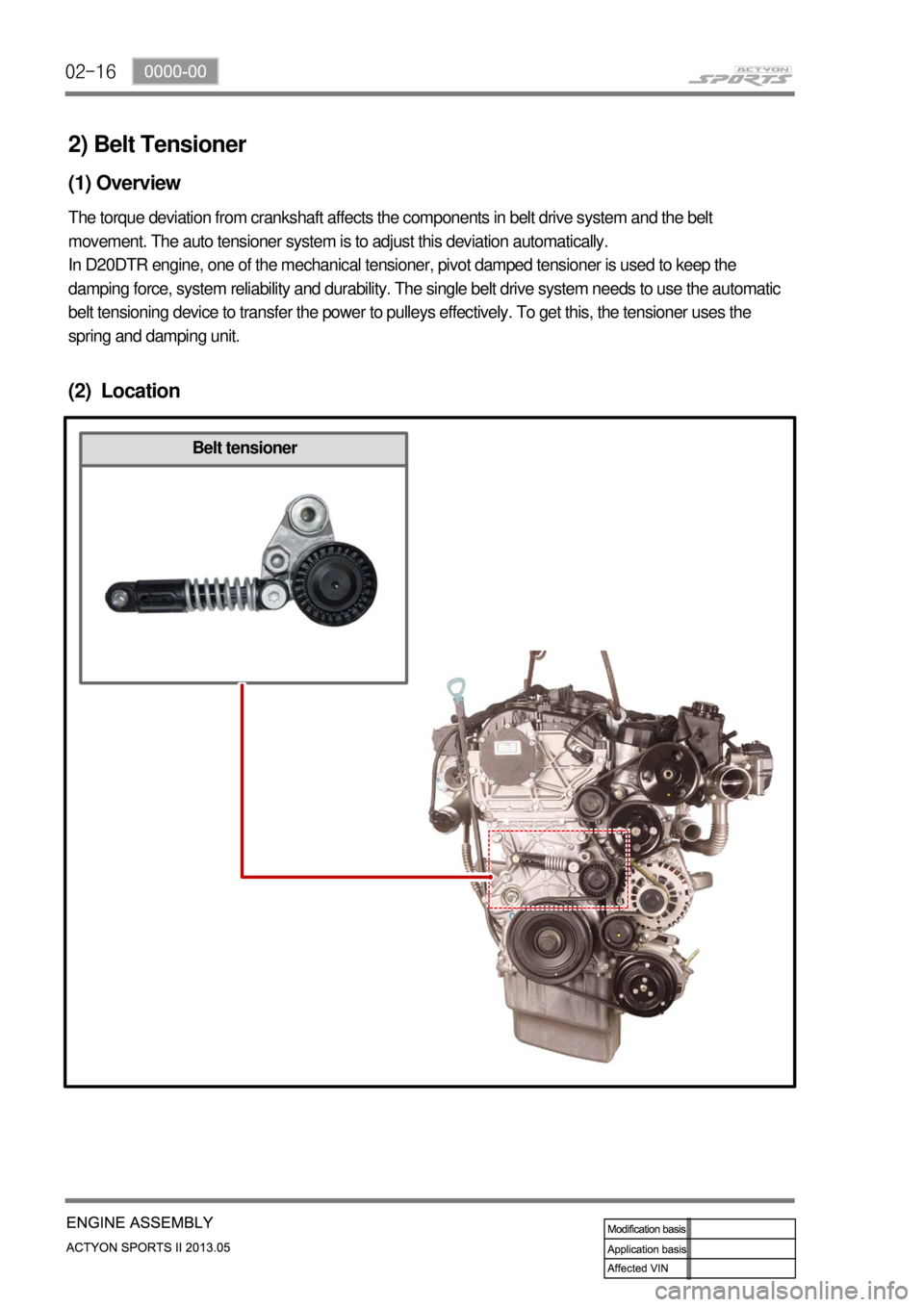
02-16
2) Belt Tensioner
(1) Overview
The torque deviation from crankshaft affects the components in belt drive system and the belt
movement. The auto tensioner system is to adjust this deviation automatically.
In D20DTR engine, one of the mechanical tensioner, pivot damped tensioner is used to keep the
damping force, system reliability and durability. The single belt drive system needs to use the automatic
belt tensioning device to transfer the power to pulleys effectively. To get this, the tensioner uses the
spring and damping unit.
(2) Location
Belt tensioner
Page 48 of 751
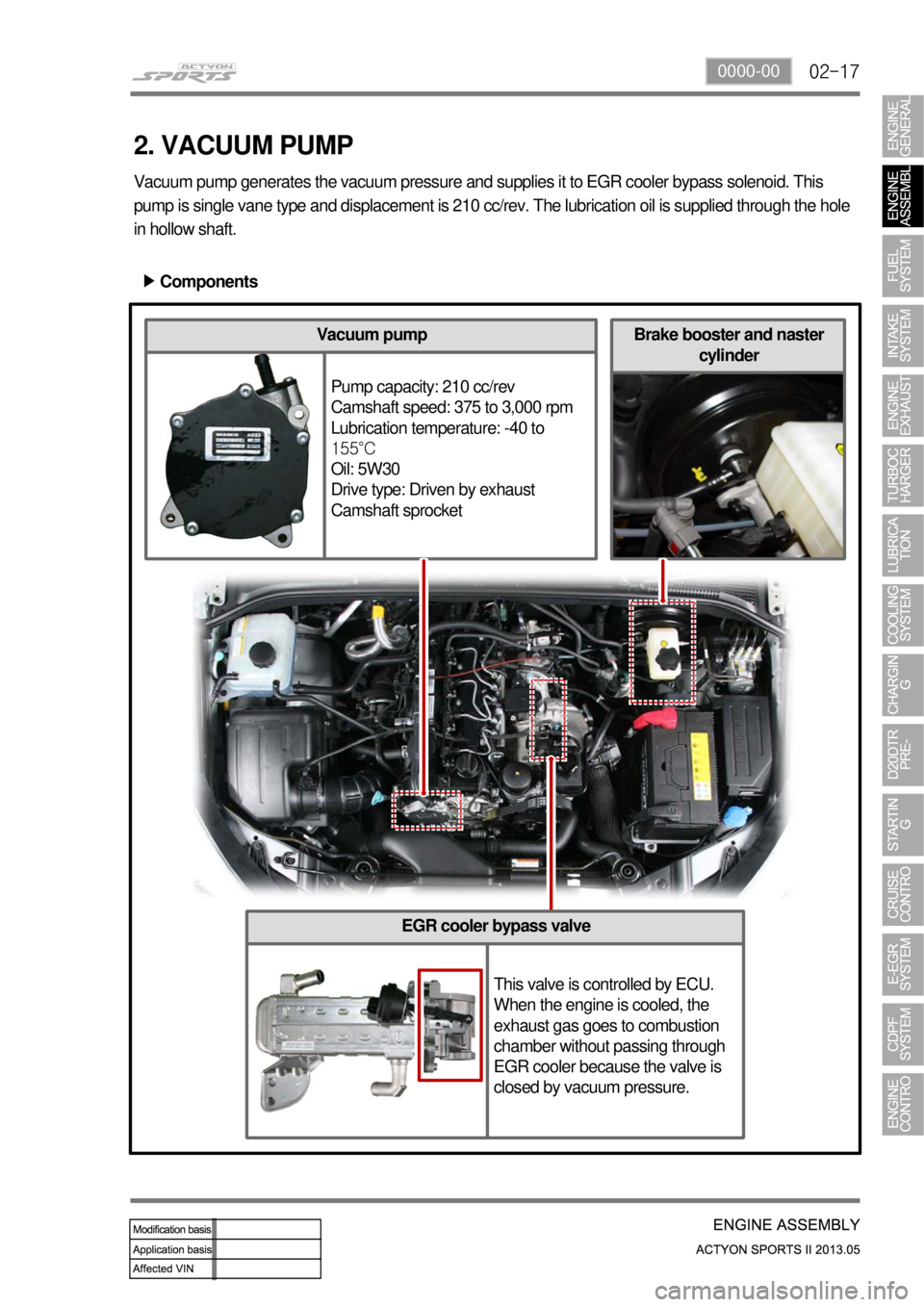
02-170000-00
Brake booster and naster
cylinderVacuum pump
Pump capacity: 210 cc/rev
Camshaft speed: 375 to 3,000 rpm
Lubrication temperature: -40 to
155°C
Oil: 5W30
Drive type: Driven by exhaust
Camshaft sprocket
2. VACUUM PUMP
Vacuum pump generates the vacuum pressure and supplies it to EGR cooler bypass solenoid. This
pump is single vane type and displacement is 210 cc/rev. The lubrication oil is supplied through the hole
in hollow shaft.
Components ▶
EGR cooler bypass valve
This valve is controlled by ECU.
When the engine is cooled, the
exhaust gas goes to combustion
chamber without passing through
EGR cooler because the valve is
closed by vacuum pressure.
Page 50 of 751
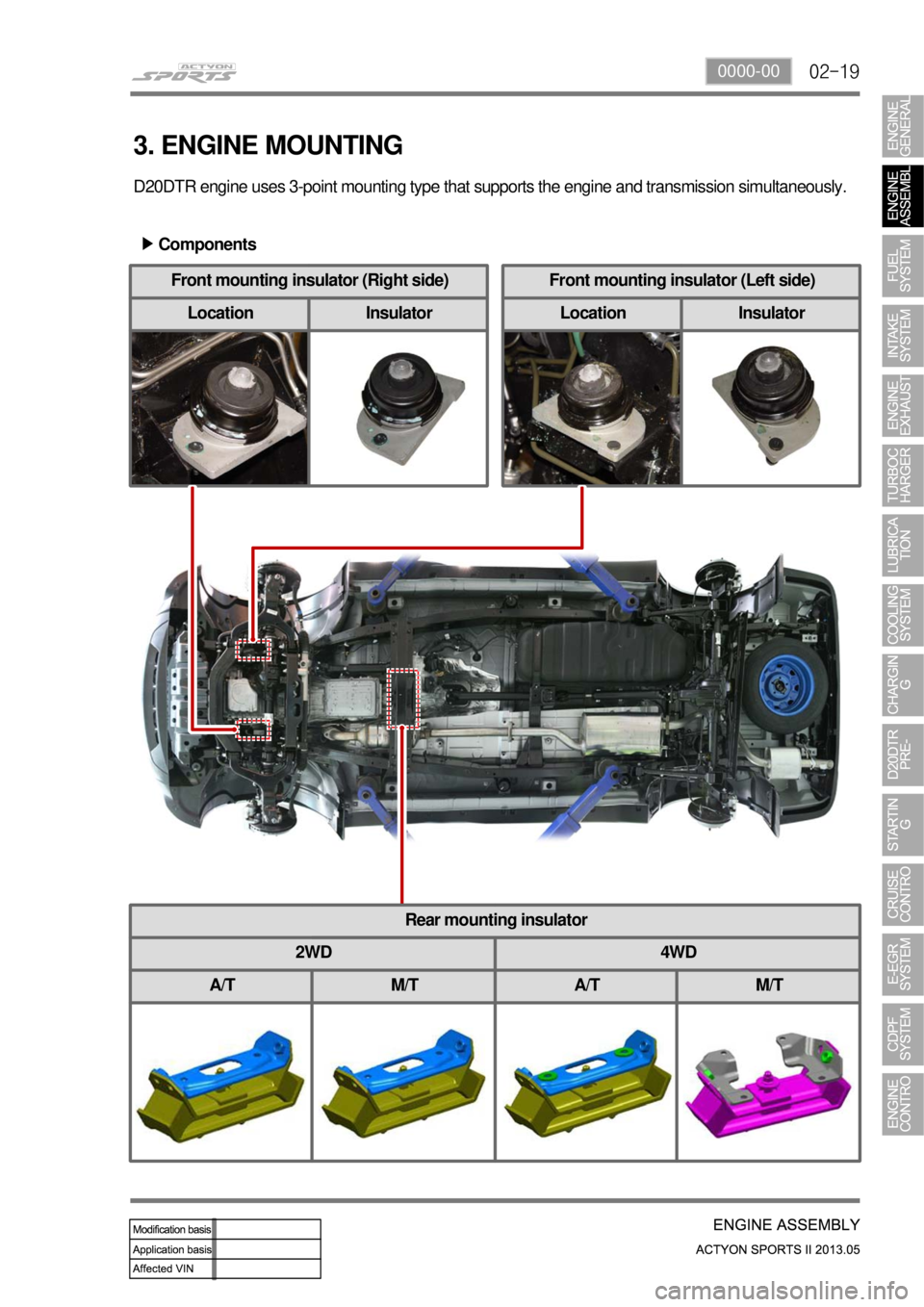
02-190000-00
Front mounting insulator (Left side)
Location InsulatorFront mounting insulator (Right side)
Location Insulator
3. ENGINE MOUNTING
D20DTR engine uses 3-point mounting type that supports the engine and transmission simultaneously.
Components ▶
Rear mounting insulator
2WD 4WD
A/T M/T A/T M/T
Page 54 of 751
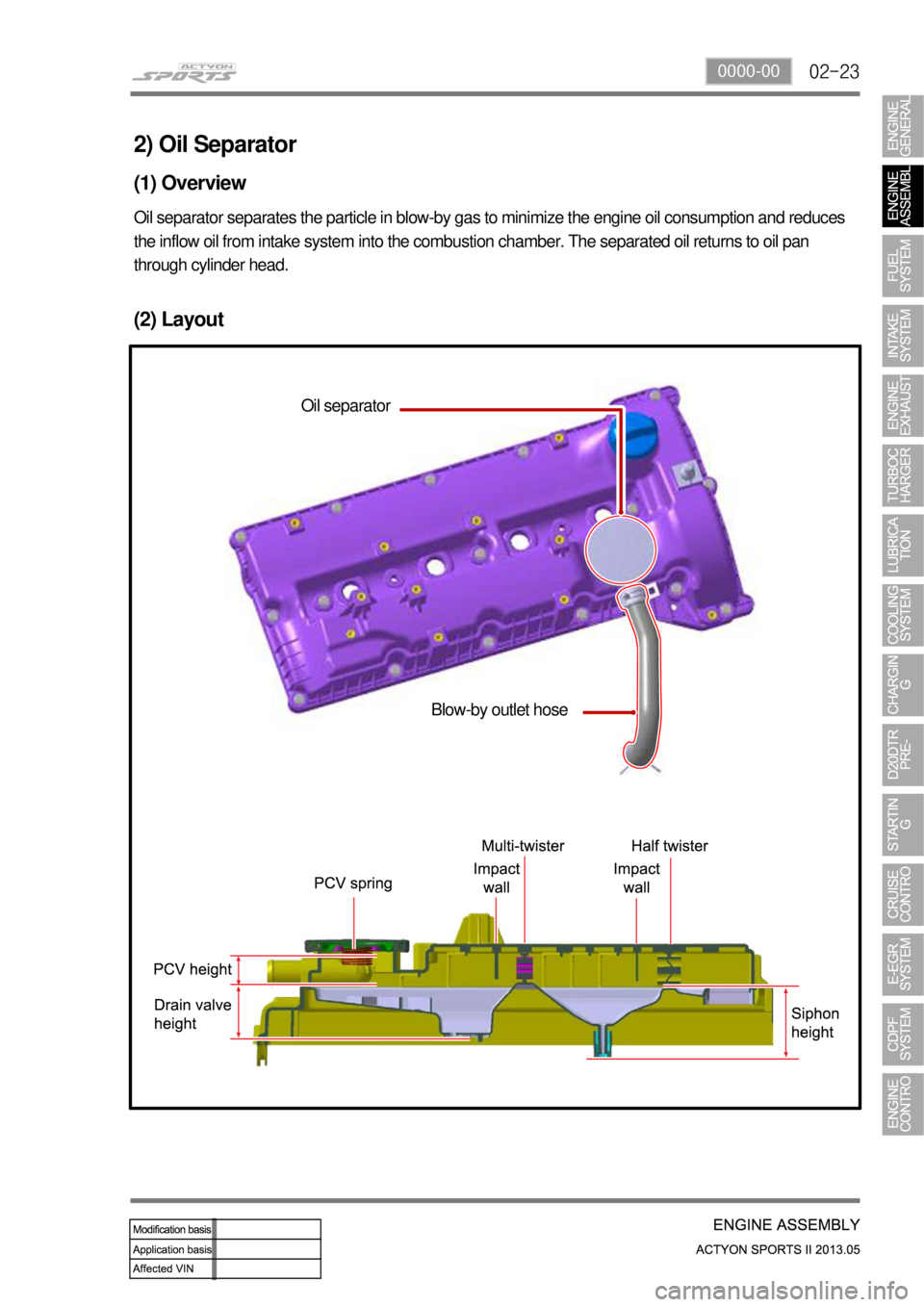
02-230000-00
2) Oil Separator
Oil separator separates the particle in blow-by gas to minimize the engine oil consumption and reduces
the inflow oil from intake system into the combustion chamber. The separated oil returns to oil pan
through cylinder head.
Oil separator
Blow-by outlet hose
(1) Overview
(2) Layout